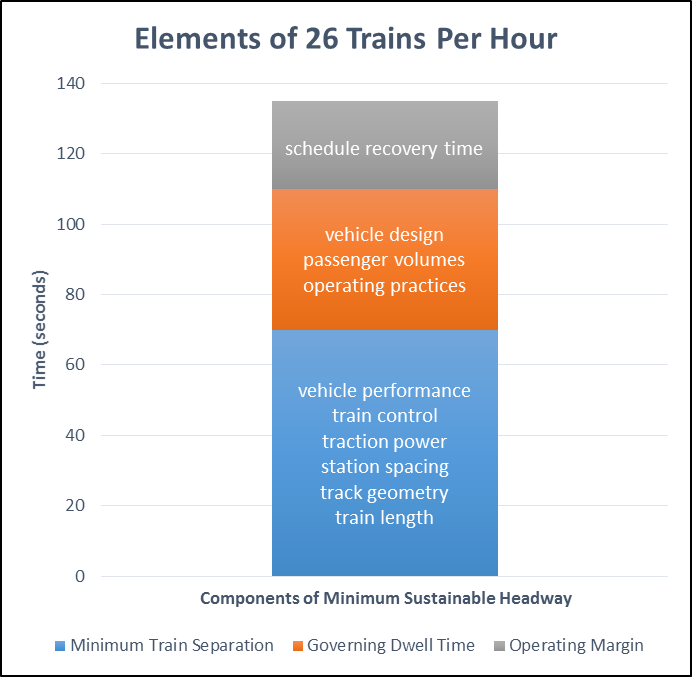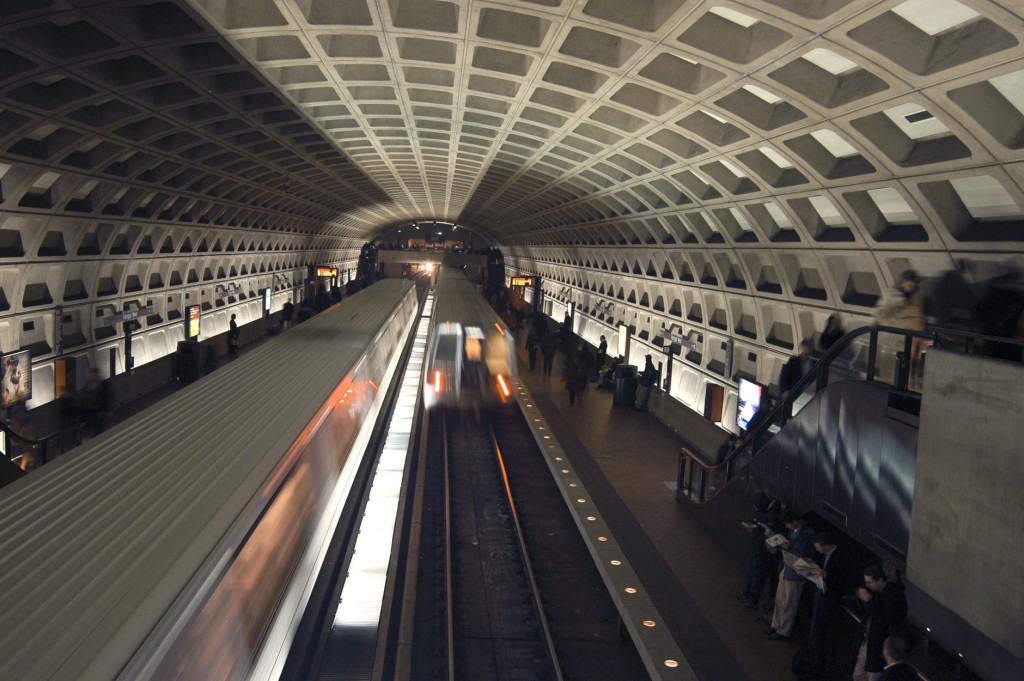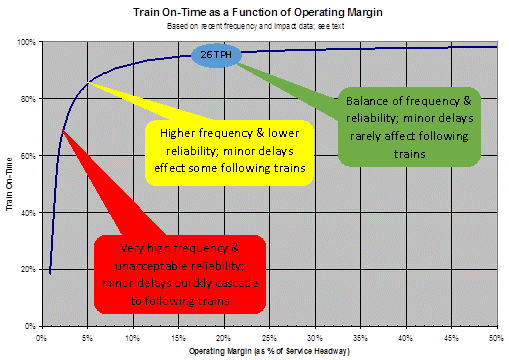The Origins of Metro’s 26 Trains Per Hour Limit
Why can’t Metrorail reliably operate more than 26 trains per hour per direction? A 2001 study defined the basis for determining this constraint.
Although it has been known for years, the July 2014 opening of the Silver Line and corresponding reduction of rush hour Blue Line service highlighted that Metro cannot schedule more than 26 trains per hour (or a train every 2-2.5 minutes) across any point in its rail network. Though it’s been discussed many times through the years, let’s explain this limit in detail now.
The components of Metrorail’s minimum sustainable headway are: minimum train separation (about 70 seconds), governing dwell time (about 40 seconds), and what’s called an operating margin (about 25 seconds). Train separation is determined by primarily by the vehicle’s ability to accelerate quickly up to its maximum speed and brake safely to a stop, the train’s length, and the configuration of stations, and tracks. Dwell times are determined primarily by the number and width of railcar door openings and the passenger volumes at major stations on each line. The operating margin is an amount of time between successive trains that is inserted into a timetable to accommodate minor delays without significantly impacting following trains. The total of each of these values (70+40+25) yields a minimum sustained headway of approximately 135 seconds between trains, which equals about 26 trains per hour.
This limit was put to the test in 2000 where, in response to the “Orange Crush”, Metro scheduled 29 trains per hour (19 Orange, 10 Blue) through the Rosslyn portal. However the aggressive 29 trains per hour (125 second headways) schedule was rarely achieved even with a mix of shorter 4- and 6-car trains, which tend to favor close headway operation. This was primarily due to tight operating margins and unattainable dwell times, scheduled at 12 seconds outside, and 19-23 seconds inside the core (far lower than the study’s recommended 40 seconds). Metro’s train control system can accommodate close headway operations, so in certain instances one can observe successive trains less than 135 seconds apart. Nevertheless this typically occurs in certain core track segments and cannot reliably be sustained over an entire rush period, day after day across the entire network.
The study (see above graphic) revealed that lower Metrorail operating margins corresponded to reduced on-time performance. With low schedule margins, instead of being able to absorb minor delays and quickly recover, small train delays or dwell time variations propagated to multiple following trains. As this margin approaches zero the number of following trains that will be delayed by an incident ahead increases exponentially. In the simplest terms, as train throughput approaches its upper limits, service reliability tends to drop.
In recent years, reliably achieving 26 trains per hour through Rosslyn has at times been difficult, which may argue for even more emphasis on preserving schedule reliability over attempting to schedule trains more closely together. This constraint also underpins efforts to plan for additional capacity, particularly at Rosslyn. In a future post, we’ll talk about how rail operating conditions have changed in recent years and whether there are strategies available to mitigate this capacity limitation.





Chicago and New York were capable of 30 TPH in the 50s. Both systems ran trains with less separation and what are considered obsolete signalling systems. METRO’s inability to run as frequent trains derives from operating policies, and cars that have too few doors exacerbated by riders who don’t enter or exit fast enough. METRO (and BART which suffers from the same inability) were designed for fewer riders than they currently attract.
Don’t believe anything that you have read above. I present this document as proof. The only thing preventing WMATA from achieving 26 trains per hour or greater is rolling stock in sufficient quantities and the fixed infrastructure to support it.
@David: That wouldn’t surprise me as NYC subway’s system-wide ridership was higher in the late 1920s and mid 1940s than it is today. As shown in the first chart above there are various factors that contribute to a line or system’s minimum achievable headway, and Chicago (shorter trains), and New York (more doors per length of railcar) have some features that favor closer headway operations, even with older signal systems. As you note, passenger behavior plays a small role in the ability to achieve short dwell times and improve throughput.
@Sand Box John: As I said, Metro’s train control system is designed for close (~90 second) headways, but that train spacing is typically only for brief recovery purposes and is not sustainable or supported by the current infrastructure. Most global metro/heavy rail systems with much higher passenger volumes, more rolling stock and robust infrastructure than Metrorail do not achieve above 30 trains per hour per direction (120 second headways), mostly due to lengthy dwell times at major stations that limit closer headways.
We’ll dive into some of these issues in more depth in a future post.
Moscow metro has been doing 40 trains per hour for decades with 8 car trains.
Here’s what WMATA could implement:
On the 8000 series:
-Open gangways
-Longitudinal seating down the entire train
-Ability to operate on CBTC
-Faster acceleration and deceleration
-8 doors per car (4 on each side)
-Vertical grasp poles at each pair of doors (see Paris Metro Line 1 — design allows more people to hold it)
-Overhead straps (like the 5000 series, but not metallic)
And in the future, if 8 doors per car continues to be implemented:
-Platform-edge doors
-CBTC (capable of a sustained operation of 42 TPH — which wouldn’t be needed for a long time, but would be good to have on hand in the future).
-Passenger Info Displays with countdowns in minutes/seconds until front of train enters station platform area
Such improvements would bring huge capacity benefits to existing lines, and would make maximum possible use of existing infrastructure (defeating the argument against construction of new HRT lines when ridership levels exceed the ability of an existing HRT corridor to serve those riders). In addition, it would provide a template for new HRT lines to go by *during* construction, meaning the new line can operate at the best of its ability from the start (e.g. A new blue line, or a new yellow line).
Current capacity in core sections, assuming 26 TPH with 9 TPH being 8-car, the rest being 6-car, and a maximum safe capacity of 120 people per car:
(17•6) + (9•8) = 174
174•120 = 20,880
20,880 people per hour per direction
With new capacity improvements, assuming total 8-car train capacity with open gangways at 1056 (960+96 = 1056 — open gangways can provide a 10% increase in capacity per train); and assuming a starting train frequency of 33 per hour after CBTC is in place and ready to go:
1056•33 = 34,848 people per hour per direction
That’s an increase in capacity of 59.9%! And from there, TPH can increase as ridership merits it:
36 TPH = 38,016 pph per direction
40 TPH = 42,240 pph per direction
42 TPH = 44,352 pph per direction
This would certainly satisfy crowding for a while, if we implemented this before expansion.
However, as there are fairly large sections of the District with no Metrorail line nearby, I think the first priority between expansion of service area and maximization of existing lines should be expansion. Just wanted to throw the idea of CBTC and 8000-series improvements out there.
-Tim
8-door trains would help with train through-put. Building a second station in Rosslyn (stub-end terminal) for the Blue line with a walking transfer to the Orange/Silver trains into downtown DC would eliminate the switching movement which reduces capacity at Rosslyn. This would also allow WMATA to operate the Blue line on a headway better than 12 minutes if loading levels warranted it.